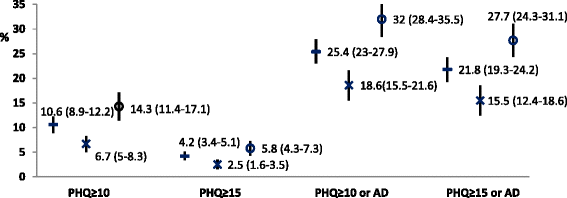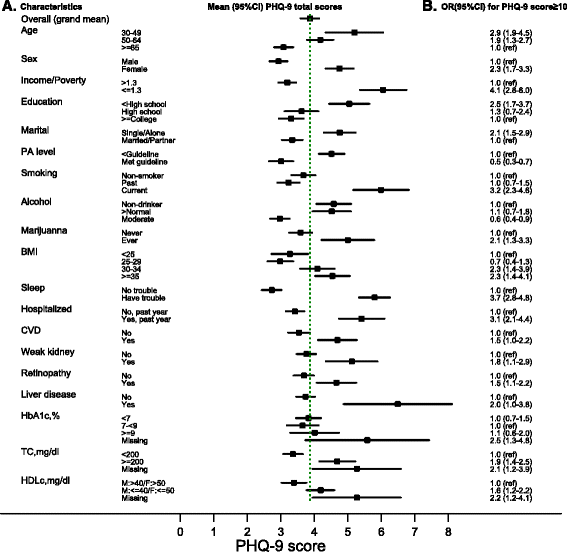Depression among people with type 2 diabetes mellitus, US National Health and Nutrition Examination Survey (NHANES), 2005-2012
- PMID: 27044315
- PMCID: PMC4820858
- DOI: 10.1186/s12888-016-0800-2
Depression among people with type 2 diabetes mellitus, US National Health and Nutrition Examination Survey (NHANES), 2005-2012
Abstract
Background: Depression in people with diabetes can result in increased risk for diabetes-related complications. The prevalence of depression has been estimated to be 17.6 % in people with type 2 diabetes mellitus (T2DM), based on studies published between 1980 and 2005. There is a lack of more recent estimates of depression prevalence among the US general T2DM population.
Methods: The present study used the US National Health and Nutrition Examination Survey (NHANES) 2005-2012 data to provide an updated, population-based estimate for the prevalence of depression in people with T2DM. NHANES is a cross-sectional survey of a nationally representative sample of the civilian, non-institutionalized US population. Starting from 2005, the Patient Health Questionnaire (PHQ-9) was included to measure signs and symptoms of depression. We defined PHQ-9 total scores ≥ 10 as clinically relevant depression (CRD), and ≥ 15 as clinically significant depression (CSD). Self-reported current antidepressant use was also combined to estimate overall burden of depression. Predictors of CRD and CSD were investigated using survey logistic regression models.
Results: A total of 2182 participants with T2DM were identified. The overall prevalence of CRD and CSD among people with T2DM is 10.6 % (95 % confidence interval (CI) 8.9-12.2 %), and 4.2 % (95 % CI 3.4-5.1 %), respectively. The combined burden of depressive symptoms and antidepressants may be as high as 25.4 % (95 % CI 23.0-27.9 %). Significant predictors of CRD include age (younger than 65), sex (women), income (lower than 130 % of poverty level), education (below college), smoking (current or former smoker), body mass index (≥30 kg/m(2)), sleep problems, hospitalization in the past year, and total cholesterol (≥200 mg/dl). Significant predictors of CSD also include physical activity (below guideline) and cardiovascular diseases.
Conclusions: The prevalence of CRD and CSD among people with T2DM in the US may be lower than in earlier studies, however, the burden of depression remains high. Further research with longitudinal follow-up for depression in people with T2DM is needed to understand real world effectiveness of depression management.
Keywords: Depression; Patient Health Questionnaire (PHQ-9); Type 2 diabetes mellitus (T2DM).
Figures


Similar articles
-
Depression is associated with diabetes status of family members: NHANES (1999-2016).J Affect Disord. 2019 Apr 15;249:121-126. doi: 10.1016/j.jad.2019.02.019. Epub 2019 Feb 6. J Affect Disord. 2019. PMID: 30771642
-
Late-life depression and cognitive function among older adults in the U.S.: The National Health and Nutrition Examination Survey, 2011-2014.J Psychiatr Res. 2019 Apr;111:30-35. doi: 10.1016/j.jpsychires.2019.01.012. Epub 2019 Jan 11. J Psychiatr Res. 2019. PMID: 30660811
-
Food Insecurity and Depression Among Adults With Diabetes: Results From the National Health and Nutrition Examination Survey (NHANES).Diabetes Educ. 2017 Jun;43(3):260-271. doi: 10.1177/0145721717699890. Epub 2017 Apr 23. Diabetes Educ. 2017. PMID: 28436293 Free PMC article.
-
TYPE 2 DIABETES IN PATIENTS WITH MAJOR DEPRESSIVE DISORDER: A META-ANALYSIS OF PREVALENCE ESTIMATES AND PREDICTORS.Depress Anxiety. 2015 Oct;32(10):763-73. doi: 10.1002/da.22387. Epub 2015 Jun 26. Depress Anxiety. 2015. PMID: 26114259 Review.
-
Diabetes and Obesity Trends in Tonga Over 40 Years.Asia Pac J Public Health. 2016 Sep;28(6):475-85. doi: 10.1177/1010539516645156. Epub 2016 Apr 27. Asia Pac J Public Health. 2016. PMID: 27122623 Review.
Cited by
-
Comorbidities in childhood-onset and adult-onset asthma.Ann Allergy Asthma Immunol. 2022 Sep;129(3):327-334. doi: 10.1016/j.anai.2022.05.005. Epub 2022 May 18. Ann Allergy Asthma Immunol. 2022. PMID: 35595004 Free PMC article.
-
Association of Sleep Characteristics with Tinnitus and Hearing Loss.OTO Open. 2024 Feb 28;8(1):e117. doi: 10.1002/oto2.117. eCollection 2024 Jan-Mar. OTO Open. 2024. PMID: 38420352 Free PMC article.
-
Association between screen time and depression among US adults.Prev Med Rep. 2017 Aug 16;8:67-71. doi: 10.1016/j.pmedr.2017.08.005. eCollection 2017 Dec. Prev Med Rep. 2017. PMID: 28879072 Free PMC article.
-
The Association Between Dietary Fiber Intake and Depression Among US Adults: A Cross-Sectional Study Based on NHANES Data From 2005 to 2020.Food Sci Nutr. 2025 Jul 16;13(7):e70605. doi: 10.1002/fsn3.70605. eCollection 2025 Jul. Food Sci Nutr. 2025. PMID: 40678325 Free PMC article.
-
Association of Environmental tobacco smoke exposure with depression among non-smoking adults.BMC Public Health. 2021 Sep 26;21(1):1755. doi: 10.1186/s12889-021-11780-y. BMC Public Health. 2021. PMID: 34565350 Free PMC article.
References
-
- American Association of Clinical Endocrinologists. Management of common comorbidities of diabetes [http://outpatient.aace.com/type-2-diabetes/management-of-common-comorbid..., last accessed July 2015]
MeSH terms
LinkOut - more resources
Full Text Sources
Other Literature Sources
Medical
Miscellaneous

